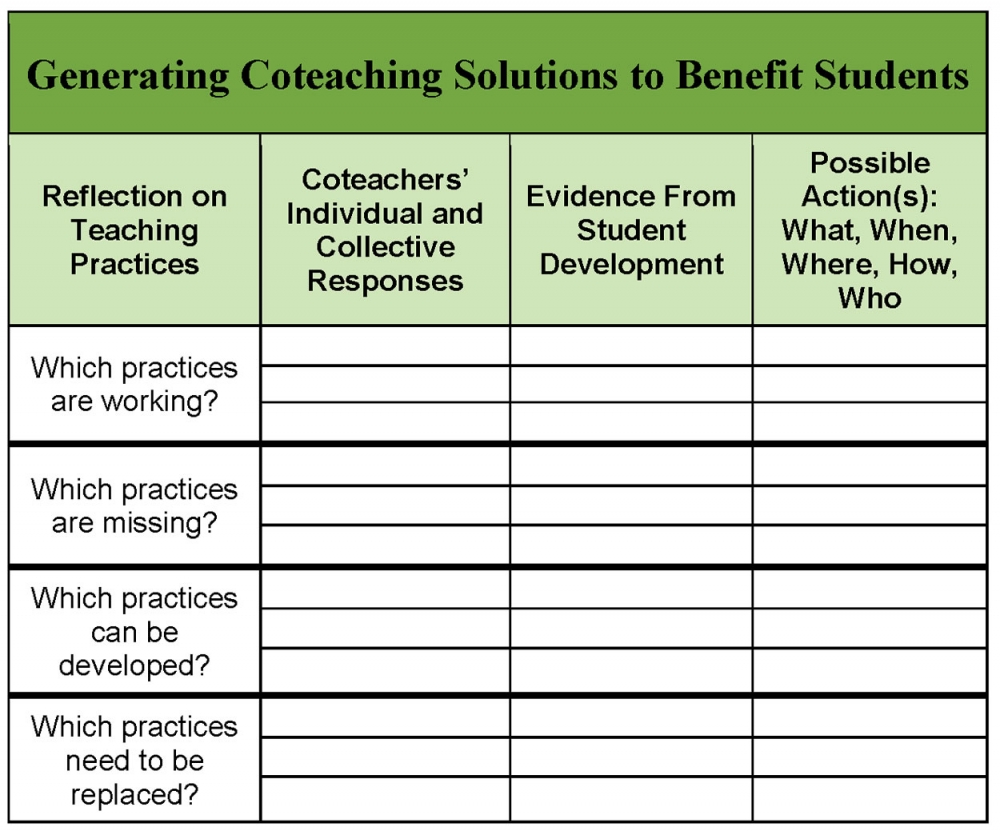
Collaborative activities have taught me how to work with diverse individuals, take on deeper self-responsibility, and appreciate other teachers’ strengths. Therefore, when I began teaching in a school with a coteaching model, I was optimistic. However, the coteaching domain, although increasingly implemented to meet the requirements of simultaneous content and second language teaching, requires more than putting teachers in a room together. Following, I explore issues related to coteaching and suggest a professional development activity for generating solutions to coteaching challenges.
Defining Coteaching
Agatha Vitale, a high school English language development/English language learner teacher, defined coteaching as “an honest, comfortable, trusting partnership; accepting and respectful of different styles of teaching and respectful of different areas of expertise. There is no more mine/yours...only ours!” (Dove & Honigsfeld, 2018, p. 10). The shift from “yours and mine” to “ours” challenges the detached conceptualization of teaching that isolates teacher responsibility. In contrast, building collaborative and coteaching practices can lead to greater student achievement due to “shared purpose, a mutual cause, and the ability to bring about change through joint action” (Dove & Honigsfeld, 2018, p. 20). When considering what and who we teach in terms of “our” goals and “our” students in contrast to “yours” and “mine,” the conversation becomes more holistic regarding not only students’ learning but also teachers’ professional development.

Forms of Collaboration
The English teaching field includes ranging contextual factors that impact students and their goals. Though much of the conversation about coteaching models is geared toward U.S. K–12 educational teaching practices (in which standards for English learners [ELs] involve social and academic language learning along with multiple content areas and other services), collaborative practices can potentially benefit all teachers in their development and students in their achievement. According to Hattie (2015), the high variability in student achievement within schools may be due to inconsistency among the effectiveness of teachers; however, when there is collaboration among teachers, higher collective efficacy can result (as cited in Dove & Honigsfeld, 2018, p. 2).
Joint Professional Learning
In considering collaborative practices within varied educational, cultural, and linguistic contexts, it is important to highlight multiple forms of collaborative practices. Dove and Honigsfeld (2018) describe multiple ways in which collaboration can occur in instructional settings, including planning, curriculum mapping and alignment, parallel teaching, codeveloping teaching materials, collaborative assessment of students’ work, classroom coteaching, and joint professional learning (p. 11). Joint professional learning may include
- collegial circles,
- peer visitations,
- collaborative coaching and mentoring,
- research and development,
- collaborative inquiry (action research),
- lesson study,
- professional learning communities,
- collaborative learning teams, and
- professional learning networks (such as TESOL interest sections for TESOL members). (Dove & Honigsfeld, 2018, p. 12)
Colearning
Coteaching provides opportunities for teachers’ colearning, which “dismantles asymmetrical power relationships in the classroom; it builds a more genuine community of practice...toward dynamic and participatory engagement in creating a peaceful and sustainable world” (Brantmeier, 2013, p. 97). Colearning occurs when individuals are equally valued for what they bring to the collaborative space. Coteaching serves as a model for students’ cooperation with their peers, and when teachers and students are engaged in purposeful collaboration, learning is enhanced for teachers and students alike.
Issues in Coteaching
Vulnerability and Power Equity
Coteaching may require teachers to exercise vulnerability, which Brown (n.d.) in her work on shame and vulnerability defines as “uncertainty, risk, and emotional exposure.” Coteachers may be uncertain about their individual or collective decisions, run the risks associated with trying new teaching approaches with another team member, and be required to confront their own and others’ emotions openly through effective communication (e.g. expressing feelings of frustration or anger about unmet expectations, seeking and giving appreciation and respect). Though it is challenging to confront, Brantmeier (2013) considers vulnerability as foundational for colearning opportunities. To fully engage in the coteaching process not only as coplanners and coteachers but also as colearners, teachers will confront vulnerability, an integral part of the establishment of power equity necessary for colearning spaces.

Additional Issues
Some issues that may arise in coteaching of ELs include mixed expectations regarding the role of the EL specialist, lack of knowledge regarding teaching ELs, assigning coteachers without establishing the full instructional cycle of collaboration (planning, instruction, assessment, and reflection), lack of trust and effective communication, lack of administrative support, and no common planning or reflection time (Dove & Honigsfeld, 2018). Administrative support is crucial, as coteaching requires opportunities for collaboration. In my own coteaching experience, administrative support and leadership as well as establishing rapport and improving communication practices with my coteachers were areas that greatly improved our efforts.
Moving Toward Solutions for Coteachers
According to Speck and Knipe (2005), “high-quality professional development is a sustained collaborative learning process that systematically nourishes the growth of educators (individuals and teams) through adult learner-centered, job-embedded processes” (pp. 3–4). Reflective protocols such as those provided by Dove and Honigsfeld (2018) can help coteachers reflect on and grow in their practices together. Visible thinking routines, such as Compass Points from the Harvard Graduate School of Education’s Project Zero, can also be used as professional development activities by coteaching teams to generate solutions.
Following, I have provided an activity, inspired by these protocols, that coteachers can use to develop actionable solutions for implementing agreed upon coteaching practices. This activity, designed to center coteachers’ attention on student achievement, can be used synchronously through in-person or online meetings or can be used asynchronously using an online collaborative tool, such as Google Docs.
Conduct this activity in coteaching teams or collaborative discussion groups.
Step 1
Begin by downloading the graphic organizer (Appendix A; .docx or .pdf):

Step 2
Each teacher should fill in responses individually on a copy of the organizer, then merge coteachers’ individual responses in a shared copy of the graphic organizer.
Step 3
Agree on group roles to keep the discussion moving forward: recorder, timekeeper, facilitator, clarifier, and so on. As a team, identify the areas multiple coteachers agreed on in their individual brainstorms.
Discuss the evidence from student development for these identified areas and review ideas for possible shared or individual actions, paying attention to the details of what, how, when, and where these actions will be implemented, as well as who (i.e., one coteacher or multiple) will take responsibility.
Continue the same process with the other responses that were generated, prioritizing those that have clear evidence from student development or performance.
Step 4
Share the final document, which includes the team’s actionable solutions, with other coteaching teams to expand on possible solutions.
Step 5
Choose a manageable number (one to three) of the top sustainable ideas to commit to implementing as a coteaching team within a given timeframe. Document and follow up on this agreement after a period of implementation to create sustainable rather than one-shot professional development.
Tips for Success
Solutions are not universal and depend on the buy-in of those involved and the particular needs of students within a given context. Depending on your context, to establish a positive and productive collaborative partnership, consider
- creating a partnership agreement,
- being open and honest,
- setting up a weekly common planning time,
- bringing school leaders into the planning process, and
- keeping the focus on what is best for students (Dove and Honigsfeld, 2018).
Here are some more tips:
Individualize Solutions: Solutions need to be tailored to the needs of students and the capabilities of the coteaching team.
Prioritize Alliance: Solutions determined and agreed upon by coteachers are more likely to be approached positively and address student needs than those mandated by authority.
Conduct an Initial Assessment: Begin the professional development exercise by first assessing participants’ beliefs, attitudes, and opinions about coteaching. If participants have decided that coteaching will not work for them, it may be better not to force the issue. Instead, focus the activity on solutions that serve identified student needs.
Take It Slowly: In order to create sustainable practices, it is best to implement one new solution at a time.
Although coteaching is not without its challenges, collaborative efforts that address these frustrations have the potential to result in professional growth and colearning for teachers. Celebrating successes in student achievement and personal and professional development that follow from these collaborative efforts is key to maintaining momentum. When coteachers put the learning and well-being of their students and coteachers at the center of their practices, everyone can reap rewards.
References
Brantmeier, E. J. (2013). Pedagogy of vulnerability: Definitions, assumptions, and applications. In J. Lin, R. L. Oxford, & E. J. Brantmeier (Eds.),Reenvisioning higher education: Embodied pathways to wisdom and social transformation (pp. 95–106). IAP.
Brown, B. (n.d.). Definitions. Brené Brown. https://brenebrown.com/definitions/
Dove, M. G., & Honigsfeld, A. (2018). Co-teaching for English learners: A guide to collaborative planning, instruction, assessment, and reflection. Corwin.
President and Fellows of Harvard College. (2016). Project Zero's thinking routine toolbox. https://pz.harvard.edu/thinking-routines
Speck, M., & Knipe, C. (2005).Why can’t we get it right? Designing high-quality professional development for standards-based schools (2nd ed). Corwin.
|
Download this article (PDF) |
Elise Brittain is a PhD student of culture, literacy, and language at the University of Texas at San Antonio. Elise has supported the teaching of English in multiple contexts, including as an instructor in U.S. intensive English programs, an English language learner support teacher in an international elementary school, and as an English language fellow teaching and conducting teacher training in Uzbekistan.
| Next Article |
